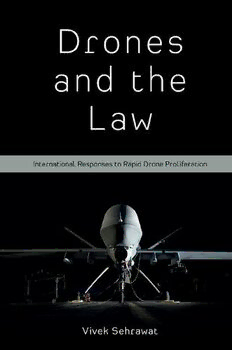
Drones And The Law: International Responses To Rapid Drone Proliferation PDF
Preview Drones And The Law: International Responses To Rapid Drone Proliferation
Drones and the Law Thispageintentionallyleftblank Drones and the Law: International Responses to Rapid Drone Proliferation VIVEK SEHARWAT BML Munjal University, India UnitedKingdom–NorthAmerica–Japan–India–Malaysia–China EmeraldPublishingLimited HowardHouse,WagonLane,BingleyBD161WA,UK Firstedition2021 Copyright©2021EmeraldPublishingLimited Reprintsandpermissionsservice Contact:[email protected] Nopartofthisbookmaybereproduced,storedinaretrievalsystem,transmittedinanyformor byanymeanselectronic,mechanical,photocopying,recordingorotherwisewithouteitherthe priorwrittenpermissionofthepublisheroralicencepermittingrestrictedcopyingissuedinthe UKbyTheCopyrightLicensingAgencyandintheUSAbyTheCopyrightClearanceCenter. Anyopinionsexpressedinthechaptersarethoseoftheauthors.WhilstEmeraldmakesevery efforttoensurethequalityandaccuracyofitscontent,Emeraldmakesnorepresentation impliedorotherwise,astothechapters’suitabilityandapplicationanddisclaimsanywarranties, expressorimplied,totheiruse. BritishLibraryCataloguinginPublicationData AcataloguerecordforthisbookisavailablefromtheBritishLibrary ISBN:978-1-80043-249-9(Print) ISBN:978-1-80043-248-2(Online) ISBN:978-1-80043-250-5(Epub) Table of Contents About the Author ix Foreword xi Acknowledgments xiii Introduction xv Chapter 1 Historical Introduction and Technology Used in Drones 1 1. Introduction 1 2. Drones 2 2.1 What Exactly Is a Drone? 2 2.2 Origin of Term Drone 4 3. Historical Background 5 3.1 Inventor of Drone: Abraham Karem and Evolution of the Predator Drone 8 4. Types of Drones 10 5. Technology Used in Drones 12 5.1 Technology Used in Surveillance Drones 12 5.2 Technology Used in Armed Drones 16 6. Technological Advantages of Drones 18 7. Technological Constraints 19 8. Conclusion 20 Chapter 2 Legality of Drones under LOAC and International Law 23 1. Introduction 23 2. The Law of Armed Conflict 27 2.1 What Is the Law of Armed Conflict? 27 2.2 Drones as Lawful Weapons 33 vi Table of Contents 2.3 Lawful Use of Drones under the LOAC 35 2.4 Just War Theory 41 3. Self-defense Theory 43 4. Geographical Location of Drone Strikes and LOAC 46 5. Command Responsibility during Drone Operations 50 6. Conclusion 52 Chapter 3 Legal Justifications for the Drone Targeted Killing 55 1. Introduction 55 2. Historical Legal Background 57 2.1 Pre-World War II 57 2.2 Post-World War II 58 3. Factors behind Targeted Killing 60 4. Definitions 62 4.1 Targeted Killing 62 4.2 Assassination 63 5. Who Can Be Targeted under IHL? 65 6. Justifications for Drone Targeted Killing in Modern Times 66 6.1 Operational Justifications 66 6.2 Self-defense Justifications 72 6.3 Moral Justification for Targeted Killing 75 6.4 Justification for the Targeted Killing of US Citizen 79 7. Conclusion 81 Chapter 4 Point Forward to Drone Proliferation 83 1. Introduction 83 2. Definitions 85 3. Military Drone Use in Disputed Borders and Applicable Law 86 3.1UseofMilitaryDroneinDisputedTerritoryand Crisis 90 3.2 Escalation of War 91 3.3 Civilian Drones Use in Disputed Territories 97 4. Violent Non-state Actors’ Drone Use: A Legitimate Concern 98 Table of Contents vii 4.1 Why Drones May Seem Attractive to Non-state Actors? 102 5. Conclusion 102 Chapter 5 Drone Privacy Laws: A Comparative of the US, UK, and India 103 1. Introduction 103 1.1 Challenges 105 1.2 Domestic Drones 107 1.3 Technology Used in Domestic Drones 110 2. Drone Use in the US 110 2.1 Drone Regulations 111 2.2 Privacy Protection against the Use of Drones by US Government Agencies through Organizational Efforts 113 2.3 Privacy Protection under the US Constitutional Law 114 2.4 Privacy Protection under State Laws 116 2.5Useof DroneonPrivate Property by Individuals 118 2.6 Drone Data Protection 122 2.7 Strong Points for Privacy Protection in the US 124 2.8 Weak Points for Privacy Protection in the US 124 3. Drone Use in the UK 125 3.1 Drone Regulation in the UK 125 3.2 Privacy Protection against the Use of Drones by the UK Government Agencies through Organizational Efforts 127 3.3Useof DroneonPrivate Property by Individuals 129 3.4 Drones Data Protection Laws 130 3.5StrongPointsoftheUKinProtection ofPrivacy 132 3.6 Weak Points of the UK in Protection of Privacy 133 4. Drone Use in India 133 4.1 Drone Regulations in India 134 4.2 Privacy Protection against Drone Use by Government Agencies 136 4.3 Drones Use on Private Property by Individuals 140 4.4 Data Protection Laws 141 viii Table of Contents 4.5 Strong Points of the India in Protection of Privacy 142 4.6WeakPointsoftheIndiainProtectionofPrivacy 142 4.7 Comparison of US, UK, and Indian Laws 143 4.8SolutionforthePrivacy Laws Related toDrones 145 5. Conclusion 147 Index 149 About the Author VivekSehrawatisanAssistantProfessorofLawatBMLMunjalUniversity.He has extensive research and publication experience in legal issues relating to nationalsecurity,internationalhumanitarianlaw,internationallaw,andprivacy law. Vivek conducted extensive research on drones during his SJD at University ofKansas.AfterfinishinghisSJD,hejoinedUniversityofCalifornia,Davis,asa Visiting Scholar. At Davis, he continued his work on drones as well as the legal implicationofautonomousweaponsystems.Fromthatresearch,heauthoredthis book. At Davis, he worked on the UN Human Rights in the field of cultural rightsprojectswiththeSpecialRapporteurKarimaBennoune.Heservedonthe editorial board of the UC Davis Business Law Journal during his LLM.
